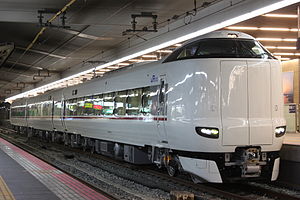The Hashidate (はしだて) is a limited express train service operated by West Japan Railway Company (JR West) in Japan. One of the services making up JR West's "Kitakinki Big X Network" in northern Kansai, it connects Kyoto Station, Amanohashidate Station and Toyooka Station via the Sanin Main Line and Kyoto Tango Railway's Miyafuku Line and Miyatoyo (Miyazu) Line. The color associated with the service is red.
 287 series EMU, January 2011 | |
| Overview | |
|---|---|
| Service type | Limited express |
| First service | 1965 |
| Current operator(s) | JR West, Willer Trains |
| Route | |
| Line(s) used | Sanin Main Line |
| Technical | |
| Rolling stock | 287 series EMU, Willer Trains KTR8000 series DMU |
Stops
editTrains stop at the following stations:
Kyōto - Nijō - Kameoka - Sonobe - Ayabe - Fukuchiyama - Ōe - Miyazu - Amanohashidate - Nodagawa - Tango-Ōmiya - Mineyama - Amino - Yūhigaura-Kitsu-onsen - Kumihama - Toyooka
Rolling stock
edit- 287 series EMUs
- 289 series EMUs (from 31 October 2015, end at 25 March 2016)
- KTR8000 series DMUs
Services are operated by 287 series electric multiple unit (EMU) trains based at Fukuchiyama Depot, and KTR8000 series DMUs from Willer Trains. 289 series EMUs converted from former dual-voltage 683 series trainsets were introduced on Hashidate services from 31 October 2015, replacing the remaining JNR-era 381 series trains.[1] After the resetting of the rolling stock in 26 March 2016, all 289 series EMUs were changed to 287 series EMUs.
-
289 series EMU, January 2016
-
KTR8000 series DMU, March 2006
Former
edit- 183 series EMUs (until 15 March 2013)
- 381 series EMUs (until 30 October 2015)
183 series EMUs were formerly used on some services, but were withdrawn by the start of the revised timetable on 16 March 2013.[2]
381 series EMUs used on Hashidate services were withdrawn following the final day of operations on 30 October 2015.[3]
History
editThis section needs additional citations for verification. (June 2013) |
The Hashidate first appeared in 1965 as a semi-express connecting Osaka and Amanohashidate via the Fukuchiyama Line, Sanin Main Line, and Miyazu Line. It became an express service in 1966. In 1968, Hashidate services were merged into Tamba services. Until March 11, 2011, the Monju and Tango Discovery were most like the original Hashidate service. From 1982 until 1992, the Hashidate was an express service connecting Fukui and Amanohashidate via the Obama Line and Miyazu Line. Two other services, the Wakasa and Taisha, had service areas that overlapped with the Hashidate.
- March 1, 1961: The Wakasa begins service as a semi-express connecting Nishi-Maizuru and Kanazawa.
- April 20, 1963: One daily round trip is added, service is extended to Fukui.
- October 1, 1964: One daily round trip is discontinued. However, until the beginning of express Asashio service between Kanazawa and Izumo-shi on 1 December, the Wakasa operates as a temporary service.
- March 5, 1966: The Wakasa becomes an express service.
- October 1, 1966: The Taisha express service begins linking Nagoya, Tsuruga, and Izumo-shi. It connects with the Asashio between Tsuruga and Yonago.
- July 1968: The Emerald express service begins, linking Nagoya and Higashi-Maizuru. Intended as a complement to the Taisha, it is introduced to ease crowding during the summer. After the Taisha service is discontinued, the Emerald continues to operate during summers until 1995.
- October 1, 1968: Asashio services are renamed Taisha. Taisha service is modified to Nagoya and Kanazawa with Izumo-shi.
- October 1, 1970: One round-trip Wakasa service is added.
- March 15, 1972: Wakasa begins operation on the Maizuru Line and Sanin Main Line. One round trip services Kyoto.
- October 2, 1978: Taisha consists to and from Kanazawa now connect Fukui and Amanohashidate.
- July 1, 1982: Taisha consists to and from Nagoya now connect Nagoya and Amanohashidate.
- November 15, 1982: Taisha service to Nagoya stops. The service is renamed Hashidate.
- November 1, 1986: Prior to the privatization of JNR, Wakasa service is reduced to one round trip daily.
- March 13, 1992: Hashidate service is discontinued.
- 1996 - Following the electrification of the Sanin Main Line, Hashidate service is reintroduced using electric trains.
- March 16, 1996: Wakasa service is modified to connect Higashi-Maizuru and Tsuruga.
- October 10, 1999: Wakasa service is discontinued.
- March 18, 2007: All services become non-smoking.[4]
- March 12, 2011: Tango Discovery services are united[clarification needed] to Hashidate services.
- March 16, 2013: From the start of the revised timetable, 183 series EMUs are withdrawn from Hashidate services.[2]
References
edit- ^ JR西日本 289系 10月31日から運転開始 [JR West 289 series to enter service from 31 October]. Tetsudo Hobidas (in Japanese). Japan: Neko Publishing Co., Ltd. 21 August 2015. Archived from the original on 21 August 2015. Retrieved 21 August 2015.
- ^ a b "JR西日本の183系が定期運用を終了" [JR West 183 series withdrawn from scheduled services]. Japan Railfan Magazine Online (in Japanese). Japan: Koyusha Co., Ltd. 17 March 2013. Retrieved 17 March 2013.
- ^ 381系が関西地区の定期運用から離脱 [381 series removed from scheduled Kansai area services]. Japan Railfan Magazine Online (in Japanese). Japan: Koyusha Co., Ltd. 31 October 2015. Retrieved 1 November 2015.
- ^ JR電車編成表 2010夏 [JR EMU Formations - Summer 2010] (in Japanese). Japan: Kotsu Shimbunsha. May 2010. p. 183. ISBN 978-4-330-14310-1.
External links
edit- JR West 287 series Hashidate Archived 2011-11-13 at the Wayback Machine (in Japanese)
- JR West 289 series Hashidate (in Japanese)